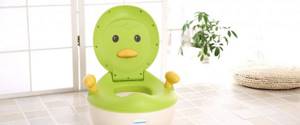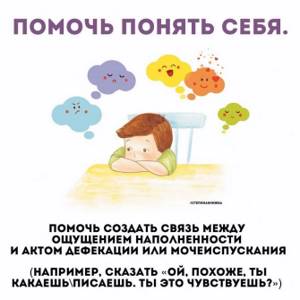When should you start potty training your child? A child aged 1-2 years, just when it is easiest to form the habit of using the potty, does only what he likes.
The task of parents is not to “scare away” the child’s desire to learn to pee in a potty, to help him get used to this new process. For a child, this is a whole discovery: he, it turns out, can pee in a potty “like a big one!”
But sometimes it can take quite a long time from the parents’ desire for their child to start using the potty as soon as possible to the realization of this skill. This period (age 1-2 years) is the most favorable time for potty training.
Many parents of 5-6 month old babies proudly boast: “And ours, ours... He’s already using the potty!” In fact, this is not an achievement of the child, but of the mother, who periodically puts the child on the potty.
According to the theory of probability (especially if you know the baby’s approximate mode of relief), periodically the child’s desire to “go to the toilet” coincides with the moment when the parent puts him on the potty.
When does a child start using the potty?
“At what age should you potty train your baby?” is a question that causes a lot of controversy among mothers.
The Russian Union of Pediatricians recommends introducing a child to the potty no earlier than 18 months. Training can take place from 1.5 to 2.5 years.
Pediatricians explain this age by the fact that children are already psychologically ready for training.
“What about planting and potty training before 18 months?” - you ask. When planting, the baby develops a conditioned reflex when it responds with a certain action to some signal. Planting requires a lot of effort on the part of the mother. At the same time, the baby can easily lose the skill due to his age.
Of course, all children are different and there are exceptions. You can start training at 1 year old, but there is a chance that the child will not want to go to the potty. In this case, be prepared to postpone training for a couple of months and start again when the baby grows up.
Do girls learn to potty earlier than boys? There are some differences in the training process depending on the gender of the child, but the essence is the same in any case. Potty training is teaching a child to control the urge to go to the toilet and be able to sit on the potty on time.
Some people believe that it is more difficult to educate a boy than a girl. This is not always the case, and the recommended weaning age is the same for both sexes. First of all, you need to look at the signs of a child’s readiness to learn, the baby’s development, the ability to concentrate on a task, and not his gender.
How to potty train a child without stress and tantrums
You can try many methods, but still fail to put your baby on the potty - simply because he is not ready for it yet. Pediatrician Ekaterina Borisovna Bulavina gave advice on parting with diapers - how to potty train a child, at what age is it better to start practicing mastering a new skill and which children's potty is better.
— Ekaterina Borisovna, at what age do pediatricians recommend potty training a child?
— Modern pediatricians around the world are of the opinion that potty training before one and a half years is irrational, since the effort and time spent result in a very modest result: the child uses the potty unconsciously, only accidentally getting into it. After 1.5 years it is much easier to master the skill. However, there are children who start using the potty at 12 months. And some people don’t sit on it even after 3 years.
At what age to potty train a child depends on his level of readiness.
How to tell if your baby is ready for the potty
| A child is ready to develop a new habit if he... |
|
| The child is not yet ready to sit on the potty if he... |
|
— What can be the consequences of early planting in a pot?
— Training too early can provoke sudden negativity towards the potty. Such reactions are due to physiological changes. A very young child learned to empty his bladder on command (“pee-pee,” mom’s intuition, the time has come), even sometimes when the bladder was not yet full or during play. Now natural control over the process begins to form. Such development leads to the need to retrain the child, but with a focus on his sensations, the urge to urinate or defecate.
It is not sound stimuli or parental requests that should encourage a child to use the potty, but the physiological process of overflowing the bladder or rectum.
— Which pot is better to choose?
— The success of the entire event largely depends on the thoughtful purchase of this accessory. To begin with, they choose three or four high-quality models on their own and then offer them to the baby to choose from. Otherwise, in a store, a child may like a completely unsuitable model, and he may refuse the one offered.

Which baby potty is better?
| Material |
|
| Ergonomics |
|
| Musical pot, pot with light effects |
|
| Correct fit |
|
| The pot is chosen correctly |
|
| Potty doesn't fit |
|
| Folding potty for travel |
|
“You shouldn’t allow a child to play with the potty, put toys in it, or pour water in it.” This makes the learning process very difficult. The child simply will not want to pee on his toy. The pot has only one function, and dolls and bears can be placed on it only for educational purposes.
Signs your baby is ready for potty training:
- The baby expresses his desires and requests in simple words
- He is ready to follow simple instructions
- Able to take off simple clothes on his own - pants with elastic and panties
- His motor skills are quite developed
- The child has no problems sleeping
- The baby has no digestive problems or chronic constipation. It is important that your child's diet is rich in water, fiber and the right fat.
- If you are still breastfeeding, structure your breastfeeding. With chaotic feedings, fluid constantly enters the baby's body, the baby will constantly urinate.
- The child shows a desire for independence
- The baby is interested in the topic of the toilet
You should not focus on a dry diaper and wait for the child to start walking for a long time in a dry diaper or wake up dry.
Potty training adds stress to a child's life. Therefore, you should not combine training with other important events in his life.
Train your baby 3-4 months before or after if:
- Are you expecting a new addition to your family in the near future?
- The baby is now starting to go to kindergarten
During training, it is better to stay at home for the first 7-10 days.
How to Get Your Toddler to Use the Toilet Instead of a Potty?
After potty training, toddlers usually prefer to use potty seats instead of adult seats. A potty seat is a more appropriate size, while a toilet seat may cause a fear of falling. The following tips will help ease the transition to a toilet seat as they grow.
- Don't force anyone to use the toilet seat. Take your time and gradually develop the courage in your child to use it.
- Buy a footrest to help him/her get up and sit on the toilet seat. This could give them the support they need on their feet and they would be less afraid.
- First, have them sit on a covered toilet seat with their clothes on. This will help them become familiar with the feeling of sitting on an adult potty seat.
- Try it out and see if it's comfortable with training seats that fit over adult potty seats.
- Some babies may feel more confident in your presence, while others prefer complete privacy. Ask your child about their preferences and act accordingly.
- Make toileting fun by giving them a book or toy while they're there.
Which potty to choose for a child
Now there is a wide range of pots of different shapes and colors. Is it worth buying a potty with toys and lights or should you pay attention to its other characteristics?
The pot should:
- Suitable for child size
- Be resilient
- Do not have entertaining elements, since we teach the child to understand his body and focus on the task. Toys will distract him from the process.
For a boy and a girl, the potty can be the same. It is not necessary to initially accustom a boy to a urinal - a potty is enough first.
Toilet rings are also not the best option as an alternative to a potty.
Children feel uncomfortable at the height of the toilet, and learning may be delayed. In addition, it will be difficult for the child to sit on the toilet on his own.
Is it necessary to first introduce a child to the potty so that he does not refuse to sit on it during training?
There is no need for special introduction to the potty. The mistake is to put the pot out in advance. The child starts playing with it, but we don’t want him to view it as a toy.
Then he will not understand why he has to write in it, and will begin to refuse to do it.
If you have already taken out the potty and the child has started playing in it, put it back and take it out in a couple of weeks.
What to expect from training
When potty training your child, you:
- Teach him to understand the needs of his body, what he feels when he wants to go to the toilet.
- Show where human waste products go
Don't expect your child to go potty right away 100% of the time. Our goal is for him to go there most of the time.
It’s normal if he refuses, you just need to understand the reasons for the refusal: whether he was in new conditions, embarrassed to ask to go to the toilet or not, whether there are problems with stool.
A child's sleep and nutrition affect the potty training process. There may be periods when the child refuses to go to the potty. This is fine.
How to Train a Three Year Old Child?
There is no one-size-fits-all approach to potty training, and parents can follow their own method. You can choose the process that works best for your baby. Here are some general steps and techniques to help potty train your child.
- Repeatedly tell them that they need to tell you when they want to pee or poop.
- Take your little one with you to buy underwear or training pants and let him pick them up. Buy one with a print of their favorite comic character, animal or vehicle to encourage them to wear it.
- Buy a potty for your baby. Most babies feel comfortable in the potty when their feet touch the ground and they are not afraid of falling.
- Let your baby explore his toilet seat by watching or touching it. Buy a potty in your baby's favorite color. You can take your little one shopping for a potty seat and let him/her choose one.
- Start by emptying the contents of the dirty diaper onto your baby's potty in his/her presence. This will help you reassure your baby that the potty is the place where the child “pee” and “poop” belong.
- First, let them sit on the potty seat with their clothes on. This will help them get comfortable with the potty seat. Let them get up whenever they want.
- You can use a toy or ask an older sibling to demonstrate while sitting in one. This will increase interest.
- Once they feel comfortable in the seat, remove their pants and place them in the toilet seat. Give them a toy or book to keep them occupied.
- Don't scold them if they can't pass urine or stool while sitting on the potty seat. Encourage them by telling them they can do it next time.
- Don't punish them for not being able to pee or poop on the potty seat.
FAQ
Does your child not sit on the potty until you remind him?
There's nothing wrong with that. Children are easily distracted from internal sensations. It is normal to remind your child to go to the toilet.
Why doesn't my child want to go to the potty?
- The baby does not understand that this is not a toy, if before this the potty was just standing and the child was playing with it.
- The child is afraid of new sensations. It is unusual for him to go without a diaper and to feel that the process of going to the toilet has changed.
- If your baby refuses to sit on the potty, he may be afraid of doing something wrong, for example, peeing wrong.
- Why did the child stop going to the potty?
Think about whether there have been any changes in the baby’s life—an addition to the family, moving, changing kindergarten, transferring the child to a crib without sides? These factors can cause a child to refuse to go potty. In case of incidents, you should not scold the baby, force him to sit on the potty, force him or shame him.
The child does not sit on the potty in kindergarten. What to do?
Find out how and when children are taken to the toilet in kindergarten. Perhaps the baby is embarrassed to go potty with a group. Then ask the teacher to take him separately. Or it might be the potty/toilet itself, which is unusual for him. Bring a potty to kindergarten, just like at home, then the baby will use it.
Why does a child only ask to use the potty at home?
Potty training consists of a series of steps. First, the baby learns to go to the toilet like an adult at home, then he gradually learns to do it in public places and finally during night sleep. You cannot expect a child to go to the potty everywhere at the same time after starting training. Be patient and give your baby time to master the skill well at home. Tell us how this is done in a public place.
Until what age do children go to the potty?
Potty training will take place from 18 to 30 months - in each case the age will be individual. Gradually, when the baby masters the potty, you can transfer him to the toilet. This usually happens by 3-4 years. Don't forget to use a special circle and a footrest so that your child can sit comfortably.
When your child is ready to use the potty
Is it possible to determine from a baby whether he is able to quickly potty train? Every child is different, but there are some common signs that indicate your child is ready to learn a new skill.
It is important for parents to understand the pattern of child development, his individuality, the characteristics of the learning process itself, and their adequate state for it.
The child should be able to sit on the potty independently. Going potty is a skill. The skill must be learned. And such a skill requires maturity.
Waiting indefinitely for a child to sit on the potty on his own can take a very long time. There is an opinion that a child is not able to solve some problems on his own, for example, how to go to the toilet. The frontal lobes of the child’s brain, which are responsible for making correct decisions, are underdeveloped. By giving too much freedom of choice to a child, parents can cause the child to make poor decisions in the long term, such as staying in diapers for a long time because it’s easier that way (Jamie Glowacki).

A child can begin potty training if the following criteria are met:
- the child is healthy;
- the baby remains dry for several hours (from a walk (2-3 hours) he comes dry or remains dry after sleep);
- he can sit on the potty and get up from it;
- can express his needs with emotions, words (“I want”), and actions (if the baby understands his desires, then he is able to control the processes in the body);
- can name some items of clothing;
- knows some parts of the body;
- can communicate the need to go to the toilet (understands the meaning of the words “pee” and “poop”);
- tries to retire to go to the toilet (the baby is aware of the intimacy of the process, awkwardness and shame if this process occurs in public ( an important sign of the child’s readiness to use the potty );
- the urge to defecate is predictable (freezes);
- stability of bowel movements;
- does not like wet diapers and panties (expresses negative emotions when wearing wet clothes or a diaper);
- no stressful situations in the family;
- tries to dress and undress independently.









